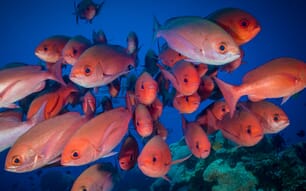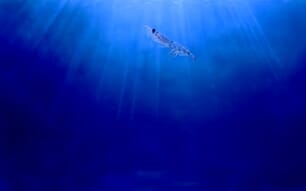Identity
Chanos chanos Forsskål, 1775 [Chanidae]
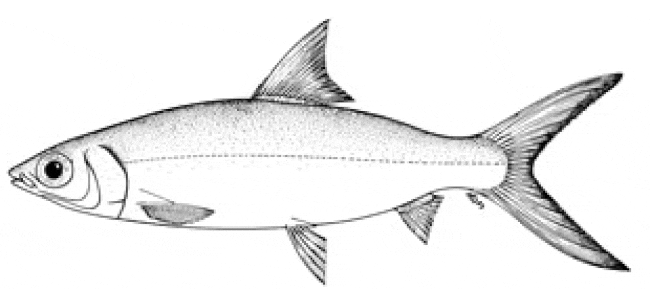
Biological features
Body fusiform, elongated, moderately compressed, smooth and streamlined. Body colour silvery on belly and sides grading to olive-green or blue on back. Dorsal, anal and caudal fins pale or yellowish with dark margins. Single dorsal fin with two spines and 13-17 soft rays. Short anal fin with two spines and 8-10 soft rays, close to caudal fin. Caudal fin large and deeply forked with large scale flaps at base in adults. Pectoral fins low on body with axillary (inner basal) scales. Pelvic fins abdominal with axillary scales and 11 or 12 rays. Scales cycloid, small and smooth, 75-91 on lateral line. No scutes (modified pointed scales) along belly.
Transparent "adipose" tissue covers eye. Mouth small and terminal without teeth. Lower jaw with small tubercle at tip, fitting into notch in upper jaw. No bony gular plate between arms of lower jaw. Four branchiostegal rays supporting underside of gill covers. Gill rakers fine and numerous. Attains typical length of one metre but may reach maximum length of 1.8m (male).
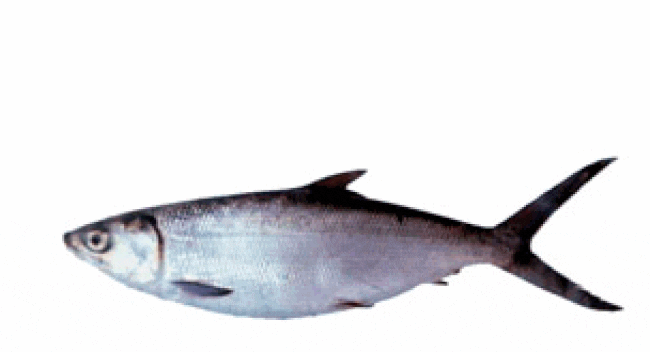
Profile
Historical background
Milkfish farming in Indonesia, Taiwan Province of China and the Philippines started about four to six centuries ago. Culture methods in a variety of enclosures are constantly being improved upon.
Since the 1970s, large investments have been made in the Philippines (as well as in Taiwan Province of China, Indonesia and Hawaii) in terms of infrastructure, research, credit and training in support to the milkfish industry.
For example, the Southeast Asian Fisheries Development Center (SEAFDEC) Aquaculture Department (AQD) was established in Iloilo, Philippines in 1973 with a special remit to find solutions for milkfish aquaculture problems. Government agencies and fisheries institutions were also involved in a national effort to intensify milkfish farming from the mid 1970s until now.
In this work, research and development on farming systems, breeding and fry production technologies was carried out. There was no attempt at genetic improvement but fry translocation and trade occurred between Indonesia, Taiwan Province of China and the Philippines and geographic variations and heterogeneity were documented.
More recently, unconfirmed reports indicate that milkfish are now being cultured to fingerling or juvenile size in the South Pacific Islands and in Singapore as tuna bait.
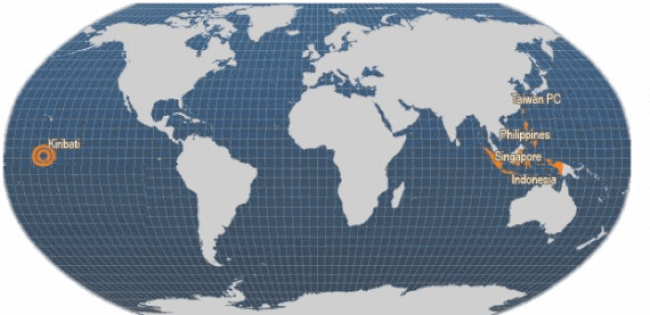
© FAO Fishery Statistics, 2006
Milkfish farming was previously a traditional industry, with little emphasis on producing sexually mature, reproductively active fish in captivity. The traditional milkfish industry depended totally on an annual restocking of farm ponds with fingerlings reared from wild-caught fry. As a result, the industry suffered from regional, seasonal and annual variations in fry availability. These variations are generally unpredictable, and may be quite large over short periods of time.
Thus, the central problem faced by the international milkfish industry was to find a way to produce a reliable, adequate, high quality supply of milkfish fry that was not subject to large unpredictable variations in time and space. During the past decade, much progress has been made, particularly in regard to milkfish propagation and the mass production of fry by private hatcheries, research institutions and government agencies. Instead of relying on wild-caught fry, milkfish farms in the Philippines, Taiwan Province of China and Indonesia now obtain the majority of their fry from hatcheries, mainly due to the significant shortage of wild-caught fry.
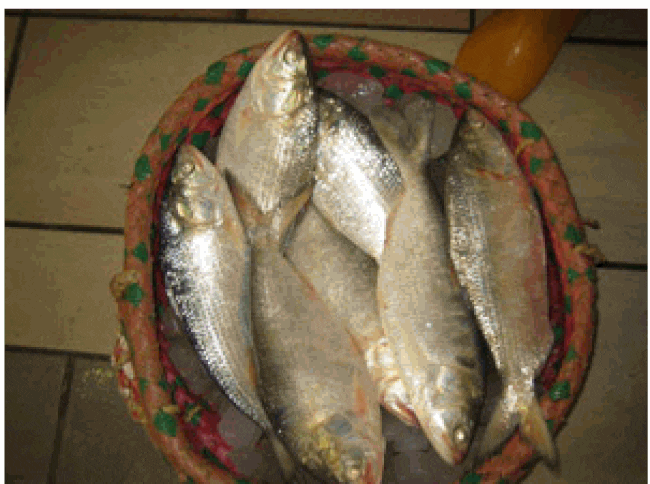
Habitat and biology
Milkfish (Chanos chanos) is the only species in the Family Chanidae. Its distribution is restricted to either low latitude tropics or the subtropical northern hemisphere along continental shelves and around islands, where temperatures are greater than 20 °C (Red Sea and South Africa to Hawaii and the Marquesas, north to Japan and south to Victoria, Australia; and in the Eastern Pacific from San Pedro, California to the Galapagos).
Adults occur in small to large schools near the coasts or around islands. They are well developed, migratory, large (up to 1.5 m and 20 kg), and mature sexually in five years. Milkfish only spawn in fully saline waters. The activity is most often correlated with the new or full moon phases, takes place mostly in the night and, in most regions, has one or two seasonal peaks. In the natural environment, spawning takes place near coral reefs during the warm months of the year, and populations near the equator spawn year-round. Juveniles and adults eat a wide variety of relatively soft and small food items, from microbial mats to detritus, epiphytes and zooplankton.
Milkfish is a heterosexual fish; hermaphrodism has not been reported. In natural spawning stocks the sex ratio is almost equal, with a slightly higher amount of females. The determination of sex is very difficult, because there are no easily identifiable morphological differences between males and females; however, the pheromone PGF2a (prostaglandin) has been found to be an effective way to identify mature male milkfish.
Milkfish eggs (1.1-1.2 mm in diameter) and larvae (3.5 mm at hatching) are pelagic and stay in the plankton for up to 2-3 weeks. Egg division begins an hour after and hatching occurs 35-36 hours after spawning. In the wild, eggs are probably released in deeper oceanic waters and in the outer reef region. Older larvae migrate onshore and settle in coastal wetlands (mangroves, estuaries) during the juvenile stage, or occasionally enter freshwater lakes. The larvae eat zooplankton and can thrive and grow in water as warm as 32 °C. They then migrate onshore and where they can be caught by fine-mesh nets operated along sandy beaches and mangrove areas; these 'fry' are 10-17 mm long and are used as seedstock in grow-out ponds, pens and cages. In the wild, juveniles are found in mangrove areas and coastal lagoons, and even travel upriver into lakes; they go back to sea when they get too large for the nursery habitat, or when they are about to mature sexually.
Milkfish can reach a maximum size of 180 cm SL (male/unsexed) and 124 cm SL (female). The maximum recorded weight and age is 14.0 kg and 15 years respectively. Resilience is low, with a minimum population doubling time of 4.5 - 14 years. Its fisheries importance is highly commercial, especially in aquaculture, and it is also used in game fish as bait. It is especially valued as a food fish in Southeast Asia.
Production
Production cycle
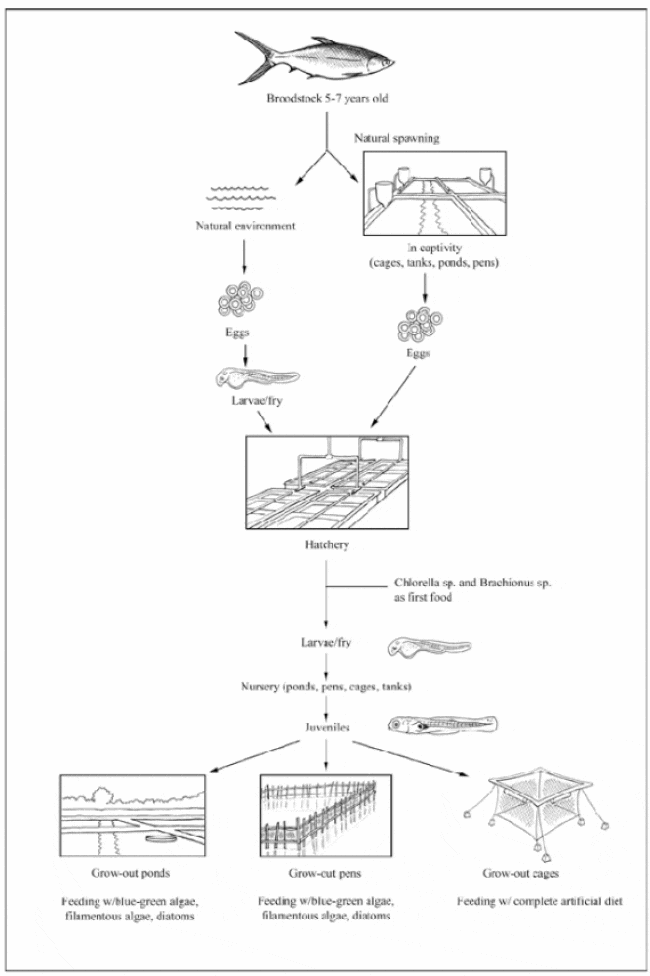
Production systems
Seed supply
Milkfish fry can either be obtained through collection from coastal areas or littoral waters or can be produced in captivity. The supply of wild fry is often unpredictable; catches in recent years have diminished and cannot satisfy the demand from on-growing farms.
Fry from captive broodstock and spawners
To develop broodstock under captive conditions, large juvenile milkfish may be stocked, fed and maintained in floating sea cages in protected coves or in large, deep, fully saline ponds (as practiced in the Philippines), or in large deep concrete tanks on land (as practiced in Indonesia and Taiwan Province of China), until they reach sexual maturity with an average body weight of at least 1.5 kg. Land-based broodstock facilities are entirely dependent on fresh pumped seawater supplies and are often integrated with a hatchery.
Broodstocks reach maturity in five years in large floating cages, but may take 8-10 years in ponds and concrete tanks. On average, first-spawning broodstocks tend to be smaller than adults caught from the wild. As a result, first-time spawners produce fewer eggs than wild adults, but larger and older broodstocks produce as many eggs as wild adults of similar size. Broodstocks of about 8 years old and averaging 6 kg produce 3-4 million eggs.
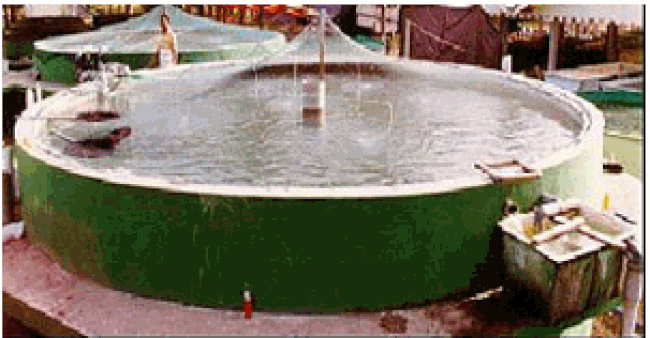
© Photo courtesy of GRIM
Breeding milkfish in captive conditions and the mass production of fry, as practised in Taiwan Province of China, Indonesia and the Philippines, is mostly dependent on natural spawning, which assures high survival rates. Artificial induction is not normally used. On days when natural spawning occurs, the fish may feed less than usual but show increased swimming activity and exhibit chasing, occasional leaping, and water-slapping activities from late noon to early evening. Spawning usually takes place around midnight but daytime spawning sometimes occurs.
Wild-caught fry
Wild-caught fry are collected with fine-mesh seines and bag nets of various indigenous designs in the Philippines, Taiwan Province of China and Indonesia. The most commonly used gear are push net "sweepers" and dragged seines.
Hatchery production
Milkfish hatcheries consist of larval rearing tanks, culture tanks for rotifers (Brachionus) and green algae (eg Chlorella) and hatching tanks for brine shrimp (Artemia). Larval rearing may be either operated in outdoor or indoor systems, depending on the specific conditions in the countries where fry are being produced.
Hatchery operations utilise either intensive (high stocking density, high volume tanks, daily feeding and water exchange) or semi-intensive (low stocking density, high volume tanks, minimal water exchange, feeding with mixed diet) systems, with an average survival rate of 30 percent (from stocked newly-hatched larvae). After hatching, the larvae are ideally kept at 50/litre in hatchery tanks (either concrete, fibreglass, canvas or polypropylene-covered earthen tanks) maintained with Chlorella and fed with rotifers during the early stages and later with copepods or brine shrimp for a total of 3-4 weeks. Following this, their size ranges between 2-3 cm and they are ready for transport to nurseries.
The fry may change hands two or more times before being used for grow-out; each time this happens, they are sorted and counted, transported, and stored for different periods of time. Fry are a highly perishable commodity and some of them die during gathering, storage, transport, nursery rearing and grow-out. The technologies for fry storage and transport are generally effective, although perhaps not yet optimised.
Fry are stored in a cool place in plastic basins or clay pots at 100-500/litre, in water of 10-25 percent, which is renewed daily. Dealers may store fry for 1-7 days, depending on the demand.
Fry can be maintained on wheat flour or cooked chicken egg yolk for 1-2 weeks but soon begin to die, despite continued feeding. Recently, micro-encapsulated feeds have become commercially available for finfish but the cost compared to conventional live feeds is higher.
Nursery
Nursery operations in milkfish producing countries vary according to established cultural practices.
In Taiwan Province of China, where commercial hatchery and nursery productions are integrated enterprises, milkfish fry are generally grown in either earthen ponds or elevated canvas or concrete tanks at intensive stocking densities of >2,000/litre.
In Indonesia, a well established backyard-type nursery is used. This consists of a series of elevated canvas or concrete 1-2 tonnes tanks and similar stocking densities to those used in Taiwan Province of China are employed.
In the Philippines, milkfish nurseries are integrated with grow-out facilities, where wild-caught or hatchery-reared fry are first acclimated into nursery compartments which comprise one third to one quarter of the total area of the Brackish water pond.
Fry are stocked at a density of up to 1,000/litre and are fed with a naturally-grown micro-benthic food known as "lab-lab" which grows on the fertilised pond bottom.
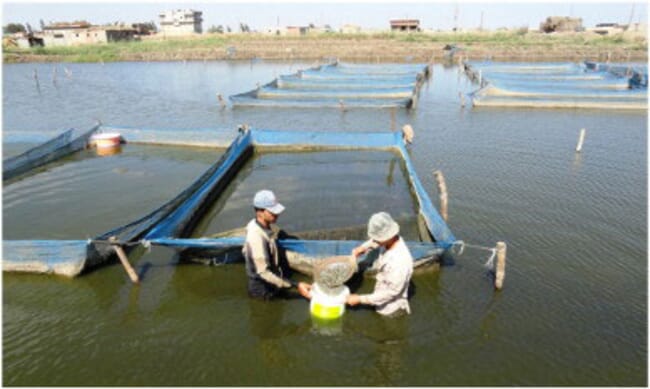
Nursery rearing has also been carried out in hapa type suspended nylon nets installed in Brackish water ponds or lagoons and in freshwater lakes within the grow-out compartments, a traditionally practice in the Philippines. When natural food is becoming depleted, artificial feeds such as rice bran, corn bran, and stale bread or formulated feeds are provided.
In about 4-6 weeks, the fry grow to 5-8 cm juveniles, which is the ideal size for releasing into grow-out ponds or pens. Depending on the desired grow-out period, juveniles or fingerling size milkfish are kept in nurseries or transition holding tanks up to the required stocking size of 30-40 g.
Nursery rearing from fry to fingerling size normally achieves 70 percent survival.
On-growing techniques
Milkfish may be on-grown in ponds, pens or cages. Pond culture of milkfish can be conducted in shallow or deep water systems.
Shallow water culture
Shallow water culture is practiced mainly in Indonesia and the Philippines. Milkfish are traditionally cultured in shallow Brackish water ponds in which the growth of benthic algae is encouraged through inorganic or organic fertilisation. Milkfish will survive on benthic algae alone only if the productivity of the algae exceeds the grazing rate of the fish; otherwise, supplemental commercial feeds are applied. The 'lab-lab' culture system in the Philippines is equivalent to shallow water culture in Taiwan Province of China. 'Lab-lab' is the term used in this country for the algal mat (and all micro-organisms associated with it) in the ongrowing ponds.

Brackish water ponds in the Philippines were mostly excavated from "nipa" and mangrove areas. Shallow water pond design generally consists of several nursery and production ponds with a typical area of 2,000 m² for nursery ponds and 4 ha for production (on-growing) ponds. Typically, ponds have a depth of 30-40 cm and are provided with independent water supplies.
The average yield of a typical integrated nursery, transition and shallow grow-out system that produces 3 crops a year is 800 kg/ha. Modified modular pond designs consisting of a series of grow-out compartments with a maximum of eight crops a year have been shown to increase yield to a high as 2,000 kg/ha.
Deep water culture
Deep water culture was developed in the mid 1970s in response to the decline of profitability of shallow water culture, and the limited and increasing value of land and manpower resources. Deep-water ponds provide a more stable environment and extend the grow-out period into the winter season. Most deep-water milkfish ponds have been created by converting either shallow water ponds or freshwater ponds, with a depth of 2-3 m. Production from these systems has sharply increased in Taiwan Province of China, having expanded from 23 percent of the total production in 1981 to 75 per cent in 1990.
Most milkfish ponds in the Philippines and Indonesia are of the extensive and semi-intensive type, with large shallow pond units, tidal water exchange, natural food, minimal use of fertiliser alternating with commercial feeds and other inputs, and low to medium stocking rates (50 000-100 000/ha). The Taiwanese method of production, on the other hand, employs intensive stocking densities (150 000-200 000/ha). Few diseases or infestations have been recorded so far in milkfish grow-out farming in these Asian countries.
Pen culture
Pen culture was introduced in the Philippines in 1979 in the Laguna Lake. At that time, the lake had a very high primary productivity, which met the nutritional needs of milkfish.
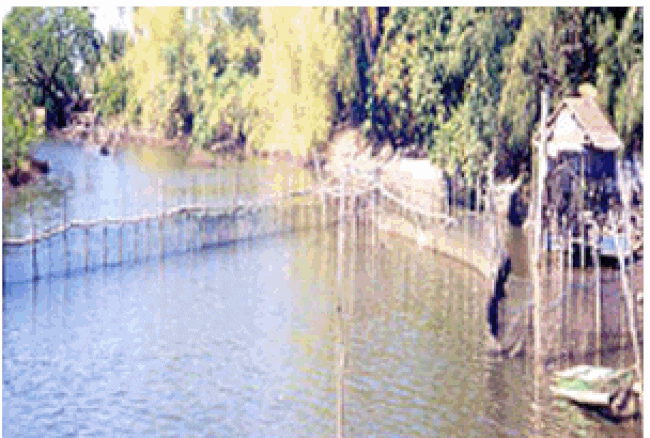
Because of the low rate of input and the high rate of return, the pen culture area increased sharply from 1973 to 1983, and exceeded more than 50 percent of the total lake surface, which is 90,000 ha. As the primary production of the lake could not meet this sudden expansion of aquaculture, and feeding became necessary to meet the nutritional requirements of the cultured fish, the pen culture practices developed in lakes were later introduced into inter-tidal areas in the Philippines along coves and river estuaries as well.
Pen operators stock fingerlings at 30,000-35,000/ha and provide supplemental commercial diets. However, disease spreads among culture pens and causes mass mortality. Government regulations are now being considered to maintain sustainable yields from this type of farming.
Cage culture
Fish cages are smaller and more restricted enclosures that can be staked in shallow waters or set-up in deep water with appropriate floats and anchors. Cage farming of milkfish is commonly carried out in marine waters along coastal bays. Stocking rates (in the Philippines) are quite high, from 5 up to 30/m³.
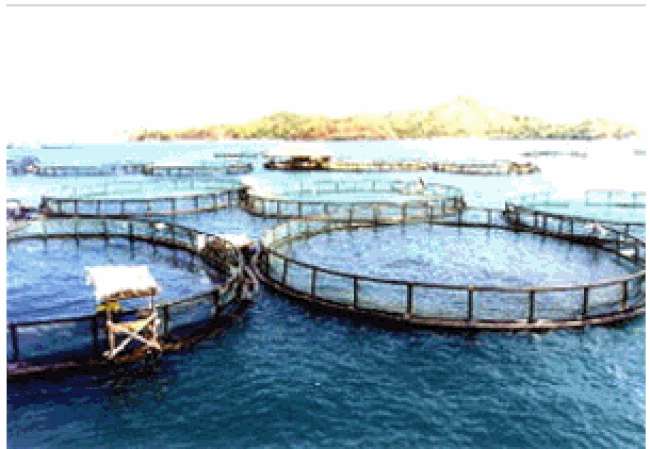
Feed supply
In the past, traditional feeding practices for milkfish grow-out production have consisted of natural food ("lab-lab") or a combination of phytoplankton and macroalgae (Enteromorpha intestinales, Cladophora spp. or Chaetomorpha linnum) encouraged by fertilisation.
In the 1980s however, special commercial feeds for milkfish were developed and became almost exclusively used. As cage and pen culture technology proliferated in the 1990s, both in marine and inland waters, extruded milkfish feeds were further developed into floating and semi-floating forms, while sinking forms were used for pond and tank-based grow-out.
Feed supplies are now manufactured commercially in the form of starters, growers and finishers, which are administered according to the production stage of the milkfish.
Harvesting techniques
Milkfish are normally harvested at sizes of 20-40 cm (about 250-500g). There are three known methods used for harvesting milkfish:
- Partial harvest. Selective harvest of uniformly grown milkfish from grow-out facilities (ie cages, pens, ponds, tanks) using seine or gillnets, retaining the undersize fish and harvesting only the commercial sized stocks, with an average body weight of 250g or larger.
- Total harvest. Complete harvest in one crop period from grow-out facilities (ie total draining of ponds by gravity or pump, hauling of the entire net cage structure, seining or the use of gillnets in pens). The harvest size at this stage may vary from 250-500g.
- Forced harvest. Emergency harvesting, regardless of fish size or grow-out stage, which is carried out during "fish kills" due to oxygen depletions that are attributed to algal blooms, red tide occurrence, pollution or other environmental causes.
Handling and processing
200-400g milkfish are harvested and marketed mostly fresh or chilled, whole or deboned, frozen, or processed (eg fresh frozen deboned, fresh frozen deboned descaled, and smoked fish deboned). In general, all marketed milkfish are produced in farms, only a few being caught from natural waters. In some countries (eg the Philippines) fishing for adult milkfish is officially banned in order to protect the natural broodstocks.
There are two known post-harvest processing techniques for milkfish, which are the traditional (ie drying, fermentation and smoking) or non-traditional methods (ie bottling, canning and freezing) and value-added products such as "surimi" and deboned products as practiced in Taiwan Province of China and in the Philippines.
Regulations and standard protocols for manufacturing milkfish products exist for both domestic consumption and export, as follows:
- Good Manufacturing Practices (GMPs). Plant construction.
- Personnel hygiene and sanitation.
- Standard Sanitary Operating Procedures (SSOPs).
- HACCP compliance.
Production costs
Milkfish farming is a centuries-old industry in Indonesia, Taiwan Province of China and the Philippines. It has been slow to modernise and now faces challenges from competing aquaculture species and current economic realities.
The domestic market is large and the export market has globally expanded. Milkfish price and personal income affect the amount of milkfish consumed in the countries of origin. Studies conducted in Taiwan Province of China and the Philippines concluded that price and income had a negative and positive elasticity coefficient, respectively.
The following are the major determining factors affecting the cost of production in milkfish:
- Type of culture system: costs are lowest in systems dependent only on natural food; costs increase as artificial feed is introduced; costs are highest in systems dependent totally on commercial feeds.
- Increasing production: with milkfish production steadily increasing and culture practices becoming more intense, a big surplus of this commodity is foreseen in the near future.
- Cost of feed: feeds account for 60 to 80 percent of the total production cost.
- Low farm-gate prices: on average, the farm-gate price for milkfish is only about USD 2.00/kg in the Philippines. As the supply of milkfish is expected to increase way above demand, fish farmers cannot demand a higher farm-gate price even though they may be spending heavily to cover production costs.
- Lack of post-harvest facilities for value-adding and processing
Diseases and control measures
The major diseases affecting milkfish are included in the table below. In some cases antibiotics and other pharmaceuticals have been used in treatment but their inclusion in this table does not imply an FAO recommendation.
| DISEASE | AGENT | TYPE | SYNDROME | MEASURES |
|---|---|---|---|---|
| Nematode infestation | Capillaria sp. | Parasitic nematode | Emaciated, although shows good appetite in early stage, then weakens, becomes listless, loses appetite & colour pattern darkens; fin & tail rot and skin patches/sores; faeces white & stringy/slimy; scrapes belly against bottom or may start to tremble; larval stage of parasite located in muscle tissue & can be seen through skin, appearing either coiled up or rod-like | Administer trichlorfon (with caution for small fish); niclosamide, levamisole or mebendazole mixed in feed |
| Anchor worm disease | Lernaea cyprinacea | Parasitic copepod | Parasite visible on skin, head embedded deep in the tissues of the host; haemorrhages and open wounds at site of infection; weight loss; respiratory difficulties; sluggishness; red areas; ulcers; scale loss; fin damage; scraping and sometimes hanging vertically or belly up; parasite length 5 to 22 mm | KMnO4 bath or 0.8-1.1 per cent NaCl (KMnO4 may be lethal to small fish at dosages required to kill Lernaea) |
| Trichodinosis | Trichodina sp. | Protozoan parasite | Slime covers skin like fog, fins clamped and denuded of tissue | 250 ml/litre formalin bath for 15 min |
| Scolex infestation | Scolex pleuronectis | Helminth parasite | Infestation occurs commonly in the intestine | None stated |
| Cryptobia Infestation | Cryptobia sp. | Protozoan parasite | Dark coloration; increased mucus build-up; occasional appearance of skin lesions followed by scale loss; difficult or rapid breathing; reduced appetite and weight loss; secondary bacterial infections in advanced stage leading to pale and/or red skin patches and skin & fin rot | Treat with formaldehyde (250 ml/litre) or 10mg/litre malachite green; place infected fish in freshwater bath or treat with effective antibacterial agents |
| Caligus infestation | Caligus longipedis | Parasitic copepod | Loss of appetite; lethargic swimming; excess mucus production; lumpy body surface | Dip infected fish in freshwater (makes transparent parasite visible); bathe in 150 ppm H2 02 for 30 minutes |
Suppliers of pathology expertise
The following are examples of locations where expertise can be accessed:
- Bureau of Fisheries and Aquatic Resources .
- The Southeast Asian Fisheries Development Center.
Statistics
Production statistics
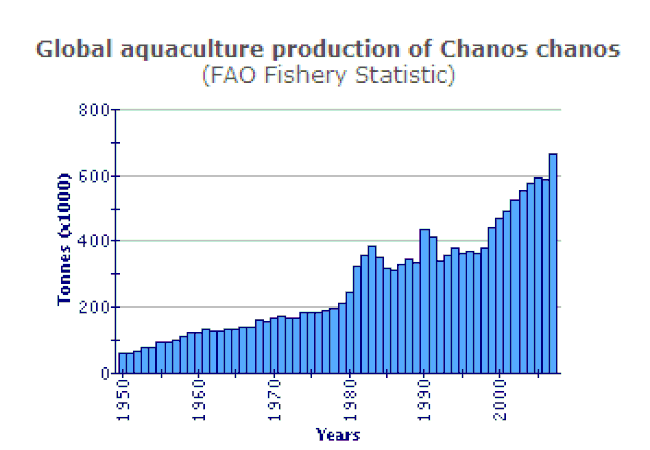
© FAO Fishery Statistics
Global annual aquaculture production of milkfish has increased every year since 1997; by 2005 it had risen to nearly 595,000 tonnes, with a value of almost USD 616 million. The most important producers at this time were the Philippines (289,000 tonnes), Indonesia (254,000 tonnes) and Taiwan Province of China (50,000 tonnes).
Market and trade
Producers of milkfish do not usually sell fish directly to consumers, but supply them through cooperatives, brokers, dealers, collectors or wholesalers, and retailers. In general, the majority of fish products are sold in auction markets through dealers, brokers, wholesalers or cooperatives to smaller dealers, and then retailers.
Increasingly, more of the milkfish harvest is processed into value-added forms: smoked, dried, marinated (brined, sweetened), fermented with rice, and canned or bottled in various styles (salmon style, sardine style, Spanish style, smoked in oil, etc.). Some companies in the Philippines now produce frozen prime cuts of milkfish bellies and backs, and even of heads and tails. Milkfish is exported in different product forms: quick-frozen, dried, canned, smoked or marinated.
The Philippines recorded an export of over 17 040 kg of milkfish products to the EU in 2002, valued at USD 58,000. While Taiwan Province of China concentrates on processed and value-added products for export to the USA, Indonesia has strengthened its export of hatchery-reared seedstock to the rest of the Asia-Pacific region for tuna bait and for grow-out.
Status and trends
Research and development
Successful induced spawning and larval rearing of milkfish were first accomplished at SEAFDEC/AQD in 1976-1978. The first generation cycle of milkfish in captivity was completed at AQD when the offspring of a wild female induced to spawn in 1978 in turn spawned in 1983.
Since then, milkfish have matured and spawned in floating cages, ponds, and concrete tanks in the Philippines, Taiwan Province of China, Hawaii, and Indonesia. Since the successful completion of larval rearing technology in 1984, fry production has increased significantly, which has not only provided milkfish farmers in Taiwan Province of China with ample supply but also opened an export market to neighbouring countries.
To date no substantial technical and scientific research has been documented from major milkfish producing countries other than the policy and management related research being conducted by the WorldFish Center, the SEAFDEC Aquaculture Department and the Bureau of Agricultural Research and BFAR of the Philippine Department of Agriculture.
Taiwan Province of China, however, has recently developed an improved strain of milkfish through selective breeding process resulting in a golden coloured F1 pioneered by a private farmer; this would accordingly command a better price than the original silvery coloured strain, once introduced in the market.
Development perspectives
The development of more efficient culture systems has resulted in higher milkfish production, which continues to increase.
Diversification of aquaculture in Taiwan Province of China, however, has paved the way for prioritising other high valued commercial marine species of fish, which has affected the growth of the milkfish industry.
Based on current trends, production in the Philippines (which has expanded its traditional land-based milkfish farming from Brackish water fishponds to marine cages in coastal communities through the establishments of mariculture parks) is expected to rise from 289 000 tonnes in 2005 to 369,000 tonnes in 2010.
Assuming that the population of the Philippines reached 84 million by the year 2005, at per capita milkfish consumption of 2.5 kg/yr the total milkfish requirement would reach 210,000 tonnes. With the actual milkfish production recorded as of 289,000 tonnes in 2005, there would have been an estimated supply surplus of 79,000 tonnes.
In Indonesia backyard hatchery production of milkfish seeds has become a rural industry at the village level. The majority of these hatcheries have further shifted to fry production of high-value species of marine finfish.
Market perspectives
Marketing of milkfish products contribute a lot to the sustainability of the industry in the major milkfish producing countries - Indonesia with its seed production exports, Taiwan Province of China with value-added milkfish products and the Philippines with whole fresh and processed products both for domestic and export markets.
The General Agreement on Tariffs and Trade GATT/WTO impositions of trade restrictions and the EU/US bio-safety and quality control standards are considerably affecting the producing countries and are foreseen to be an added burden among production costs.
Although HACCP from farm to product processing are now strictly observed (for both domestic and export markets) in the major producing countries, farmers and processors view this as another trade barrier that has been set by the importing industrialised countries.
Recommendations
The following recommendations are suggested:
- Opening up markets, both locally and abroad, for value-added products including boneless milkfish would be valuable. The Philippines is the only country in the world to produce boneless milkfish to date. Improving the distribution flow for boneless fish for local markets would also be useful.
- Investment in feed formulation to cut down production costs. Rationing the exact daily feed biomass requirements to reflect actual feed requirements is needed.
- Trimming down marketing layers. Through cooperatives, producers should be encouraged to market production directly to retailers, thereby bypassing the traditional market layers.
- Making public investments for post-harvest facilities.
Main issues
The main issues in milkfish farming can be summarised as follows:
- Producers and consumers have benefited from new technology; however, broodstock technology is still unreliable and fry supply is not fully controlled.
- Milkfish will remain a traditional foodfish in the Philippines, Indonesia and Taiwan Province of China; however, the younger generation tends to avoid eating milkfish because of their bony flesh; thus new markets will be difficult to create.
- High land values and the relatively low value of milkfish mean that farmers will have to introduce new technology to increase unit productivity.
- Milkfish aquaculture will no longer rely only on natural productivity; the use of formulated feed will become the norm.
- More hatcheries, especially in Indonesia and Taiwan Province of China, are expected to come on-stream. This, and improved spawning technology, is expected to decrease fry costs.
- New product forms need to be developed, advertised and marketed.
- As mass production of milkfish fry in hatcheries expands, more fingerlings will become available for the baitfish industry.
- Further research and development on the marketing and processing of milkfish is desirable.
Responsible aquaculture practices
Due to global market demand, major milkfish producing countries have recently been promoting management practices that address food quality and safety issues.
At the farm level for example, the Philippines complies with the minimum aquaculture HACCP requirements, from hatchery production to harvest, before milkfish products are processed for export. Taiwan Province of China has introduced product eco-labelling in order to export quality branded processed milkfish products, while Indonesia ensures the quality of milkfish fry when exporting to neighbouring Asian countries and accompanies them with health certificates.
Traceability in the use of antibiotics and unregulated drugs is already strictly imposed in these countries.
December 2009

